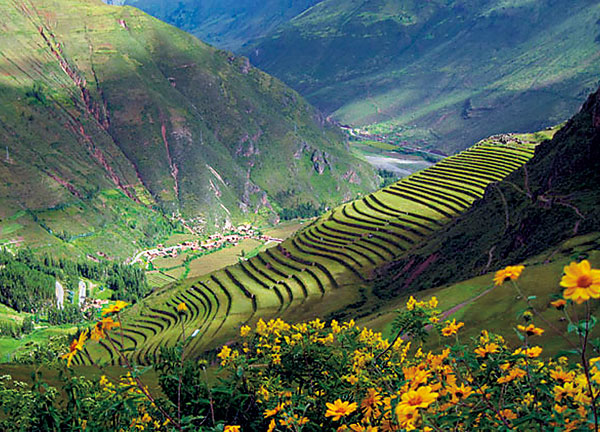Terraced hillsides in the Andes are amongst the most beautiful examples of what archaeologists refer to as “domesticating the landscape.” Generally constructed during the Incan Empire, the terraces, many of which are still farmed, are framed by often-elaborate stonework. Perhaps too elaborate for its assumed use, says archaeologist Melissa Goodman-Elgar.
Using techniques such as microscopic soil analysis and geochemistry, Goodman-Elgar explores how humans have transformed natural landscapes and the cultural implications. Much of her work is focused in the Andean highlands of Peru and Bolivia.
In the case of the terraced hillsides, however, she started from her perception as an archaeological soil scientist and explored her observations through ethnographic and historical accounts.

Throughout the Andes, pre-Columbian inhabitants transformed mountainsides too steep to farm into terraced fields in order to grow maize, wheat, and other crops. Not only does terracing enable farmers and their crops to remain on the hillsides, it controls drainage and positions the fields so that they better absorb solar radiation. Some of them were built with the same sophisticated and intricate masonry used in the monumental urban architecture of the region.
Indeed, the masonry is so sophisticated—and so overbuilt—that Goodman-Elgar suspected that maybe some of those terraces were for purposes beyond simply growing crops. She explores those purposes in her chapter, “Places to Partake: Chicha in the Andean Landscape,” of a recent book, Drink, Power, and Society in the Andes, edited by anthropologists Justin Jennings and Brenda Bowser (formerly at WSU) and published by the University Press of Florida.
Chicha, a beer made from maize, is prevalent throughout Andean culture. In fact, Goodman-Elgar proposes that it defined the use of some of those overbuilt terraces.
“The highly planned geometric designs, specialist cut-stone masonry, niches, and other embedded features are all distinctive in elite Inca architecture and serve to identify specific places with Inca hegemony,” she writes. “The use of these elite features in certain Inca terrace systems indicates that they may have had roles beyond crop production.”
Goodman-Elgar’s reasoning stemmed not only from the observation that the terraces were overbuilt, but that the soils in some of them were poor, not at all suited to the crops that they presumably supported. Her approach as an archaeologist is a studied contrast from others in the book, which start with the role of chicha in terms of ceremony and power.
“Research on chicha has tended to concentrate on its manufacture and consumption within ceremonial public spaces, domestic contexts, and institutions such as Inca acllawasi, where acclas, women dedicated to the Sun cult, prepared chicha and other goods for the state,” she writes. However, historical documents also make frequent reference to the use of maize chicha in agricultural terraces, both as an offering in ritual activities and as a beverage during group cultivation.”
“I studied it from the other side,” she says. “I studied the dirt.”
In a broader sense, agricultural landscapes generally are excluded from discussion in favor of monumental architecture and natural features as shrines, she argues. This exclusion reflects the common ideology that separates built environment from “wild” agricultural spaces.
However, Andean culture tends to break down this separation. “Terraced fields figure prominently within the plans of many pre-Columbian Andean settlements,” Goodman-Elgar writes. “This may indicate that these settlements did not reflect a notion of separate conceptual spheres for domus and agrios.”
Both Incan peasants and the ruling class seem to have used the terraces as a social venue. In such a remote and difficult landscape, not only work, but celebration and ceremony took place in the terraced fields. Many Andean communities are structured through ayllu, a social network that includes “bonds of kinship, reciprocal exchange, and corporate landholding. The Spanish found that a version of ayllu organization was used by the Inca for administration and taxation, and the ayllu may be a longstanding Andean tradition.”
One reason that particular terraces were elaborated, says Goodman-Elgar, is that a lot of social practice that we might pursue in the home or an urban social environment took place out in the terraced fields.
Not only was chicha considered sacred and offered during agricultural ceremonies, it was also used as payment for the labor expected of the ayllu participants.
The Incan state did the same, she says, only on a grander scale.
“Certain fields, particularly in the Cusco region, were elaborated because the crop of the sun was maize.” Participants would make offerings of maize and chicha, as well as llamas and guinea pigs. “The Inca emperor would come and take a gold-tipped plow and symbolically till the earth,” restarting the seasonal cycle.
